I remember the first time I noticed the concept of an abandoned cart email. It was one of those late night “window shopping” spirals, a few years ago, on a popular online store of a big clothing brand.
I kept adding things to my cart to figure out how much I needed to save from my next paycheck if I hypothetically wanted everything on my wishlist. After hours of browsing and impulsively adding things to the cart, I checked the total and it was nearly $300.
As per usual, I got distracted and left the website. It was a fun way to kill time but I had other things to do.
A few days later, I received an abandoned cart email from the brand. Whilst I thought it was a little bit creepy to be followed around the web like this, it was actually handy because I remembered there was an item in my cart that I really wanted — so I ended up grabbing it and checking out.
As the eCommerce industry has grown, and become more competitive, email marketing campaigns like this have become the standard automations to get going out of the gate.
Smaller independent stores are vying for the same eyeballs that bigger brands with an online presence are vying for. This means even smaller businesses have started employing more elaborate email marketing strategies to compete.
According to Statista, the abandonment rates for shopping carts worldwide is nearly 78% - that’s over a whopping three quarters of all people who leave their purchases incomplete. To put that into perspective, that is nearly $4 Trillion dollars lost in online revenues, solely due to abandoned carts across all online businesses, regardless of which industry they fall under. Your business’s revenue loss due to abandoned carts, is part of this fantastical number too.
What are abandoned cart emails and why are they needed?
When someone leaves an ecommerce website and their online shopping cart without making a purchase, an action is usually triggered on part of the business in the form of an abandoned cart email. While they won’t work for every kind of customer, understanding the reasons why people abandon their carts, may help you gain a better understanding of how effective such an email campaign would be for your business. A study by Baymard, showed that one of the main reasons that customers abandoned their carts, was due to high shipping costs. However, there are several other reasons that you could be losing out on revenue. Here are a few:
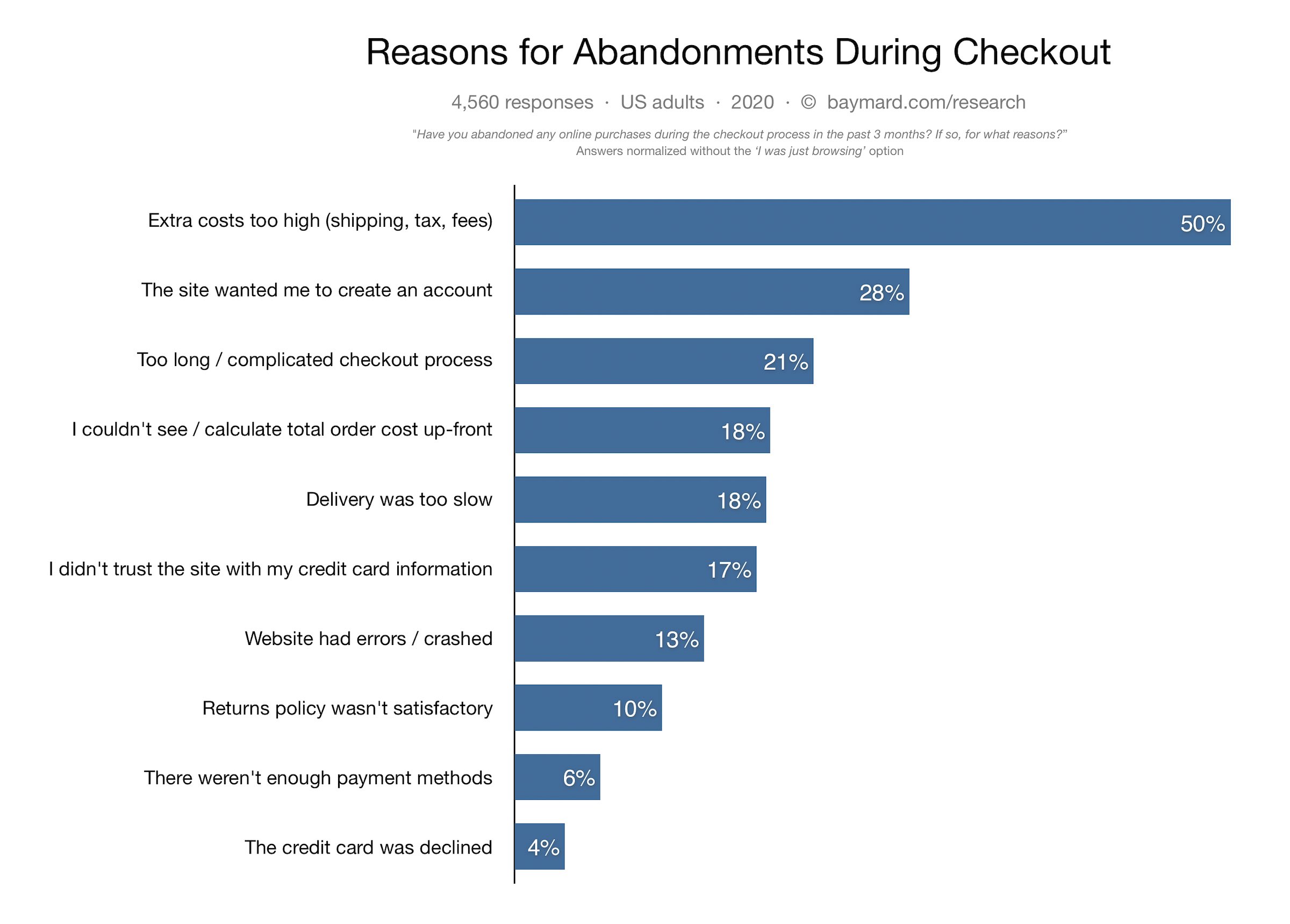 Source: Baymard
Source: Baymard
When it comes to the abandoned cart rates, the device that a consumer may be using while browsing your products may also make a difference. Research shows that desktops, laptops and tablets have lower cart abandonment rates than mobile devices.
This difference in rates between the device types may be a result of the fact that several ecommerce businesses focus on optimising their online stores for desktops/laptops and either forget to or actively choose not to focus as much on the mobile version of their stores. With mobile technology being such a big part of everyday life, if you don’t make it easy for customers to access your brand on such platforms, you lose them.
Simplifying and optimising the check-out process for mobile devices can play a huge role in bringing in that revenue.
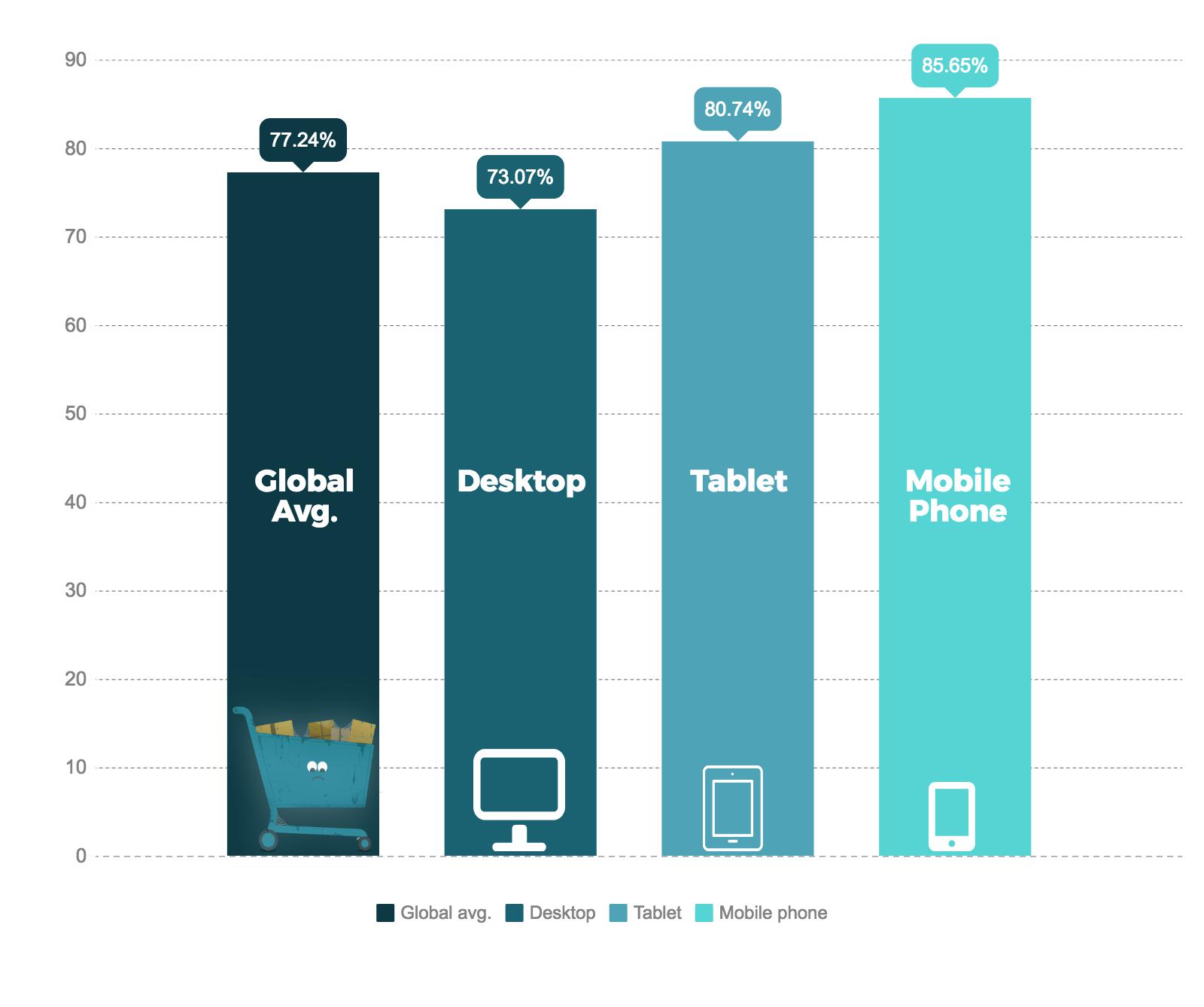 Source: Barilliance
Source: Barilliance
Research suggests that abandon cart emails are effective in making up for nearly 10% of the lost sales. While that number may not seem incredibly high, for an automated email sequence that’s a pretty sweet regain in revenue without actually having to do much.
What makes these kinds of emails even more attractive is that once you can pin down the reasons for why your customers might be abandoning their carts, you can set up a series and forget about it since these emails are automated and require considerably less personalisation than, say a welcome email series would.
Cart abandonment in terms of the conversion funnel
Your conversion funnel is the set of stages that need to be completed by your target audience, from awareness, all the way through to purchase. These are the steps that your target audience needs to follow through:
Category Awareness ↓ Brand Awareness ↓ Ad Awareness ↓ Message Association ↓ Brand Imagery ↓ Brand Consideration ↓ Brand Favourability ↓ Purchase Intent ↓ PURCHASE
Cart Abandonment occurs just before the last stage in the funnel, between purchase intent and the purchase itself. It’s important to understand that if a potential customer has gone through all the stages of the funnel, only to drop out at the last minute, they were actually interested in buying the said item(s), however they reached that “make or break point”. These are customers who are highly engaged and are even willing to actually buy your products but might need a little nudge in the right direction, for whatever reason. This should make the fact that your users shopping experience hinges on the check-out process, glaringly obvious.
Obviously, not every customer that is on your site is there to shop for sure. Case in point was my own example in the introduction. However, it is to be noted that the large number of engaged customers are actually there with purchase intent, will and ability - losing out on them due to poor process, seems silly. Experts have noted that nearly $200 Billion Dollars are lost due to poor check-out processes, annually.
So while you can’t coax every kind of customer back, there is a big segment that an abandoned cart email or even a well crafted series, might just work on.
How do I apply this to my business?
To be able to craft an effective abandon cart email or email series, it is important to know what your cart abandonment rates are and what affects that number. So how do you calculate the rate? Use this formula:
[1 - [ (#) completed purchases / (#) shopping carts created ]] * 100 = (%) Shopping Cart Abandonment Rate
The Shopping Cart Abandonment Rate is calculated by dividing the total number of completed purchases by the number of shopping carts created. Subtract the result from one and then multiply by 100 for the abandonment rate.
For example, if you have 45 completed purchases and 200 shopping carts created, the shopping cart abandonment rate would be 77.5%. 1 - (45 / 200) x 100 = 77.5%
Source: Geckoboard
Now apply the variables that are affecting your customers purchase decision.
Questions about authenticity:
- Is this seller authorised?
- Is this product the real deal or a fake knock-off?
Questions about reliability:
- Do I know anyone personally who can vouch for this product?
- Did they actually like using it?
- Why are there no reviews about this product?
- Do they have testimonials on their ecommerce site?
- Are these testimonials fake/paid for?
Questions about online presence:
- Is their social media legit?
- Are they updating regularly? When was the last post?
- Are people engaging positively with their product?
Questions/Concerns about the check-out process:
- Is it necessary to create an account to check-out?
- The check-out pages seem a bit dodgy, is it safe?
- When will I get my purchased item delivered?
- What are the extra costs/hidden fees?
- Why isn’t there any coupon code/discount?
- Why aren’t the different delivery methods available?
- What is the return/refund policy? Why isn’t it listed on here?
These are just some of the possible questions that arise in the customers mind. While these may not seem like a big deal to you, they have a direct impact on whether the customer will make the purchase or not. Remember, buying a product online vs in a store is a different experience completely. With an average person's attention span being just 8 seconds, one thought or distraction and you may lose out on a customer. This is not always the case with shopping offline, simply because of the effort invested to go to the store itself - that usually becomes a bigger motivator than anyone realises. With online shopping, it’s all at your fingertips, which means “intent to buy” can be switched on or off in a second.
How to make a good abandoned cart email/email series
So now that we understand how cart abandonment works on a deeper level, how do we create a great abandoned cart email or series? Here are the things that you need to know and focus on:
Subject Line
As it goes with most email campaigns, it all starts at the subject line. The subject line for a cart abandonment email needs to be intriguing enough for the customer to actually click and open the email itself. What’s great about this kind of email is that you can afford to be a bit more creative or edgy with the subject as it’s already established that the customer is at the cusp of making a purchase and just needs a nudge. Nearly 64% of customers actually decide to open the email based on the subject line alone so make sure that the message/intent you are trying to put across is clear from the get go.
Adidas really nailed it with their subject line for this particular email. “Is your wi-fi okay?” is a great way to create intrigue or atleast get the customer to take a second glance. The rest of the copy, just adds to the simple brilliance.

Also, remember this may be the first touch point a future customer has with your brand. Don't be creepy.
Call To Action
For your email to actually work as a tool to bring back your customer, there needs to be a clear call to action. But what most people don’t realise is that a clear call to action is not the only thing - Using a low-commitment call to action is way more effective in bringing your customers back. It’s easy to dismiss the phrasing and use harsh, high-commitment terms such as “buy”, “pay” or “check-out”. Rewriting your copy to use gentler language such as “visit your cart” is a great way of coaxing the customer back.
Check out this example of Virgin Atlantic - these guys really do the call to action thing correctly.
Not only are there 3 actionable buttons with low-commitment CTA’s (notice the “go to my basket”) on them, but their positioning is equally important in the email. Furthermore, the copy and a recap of what you’re abandoning helps make the CTA even more effective.
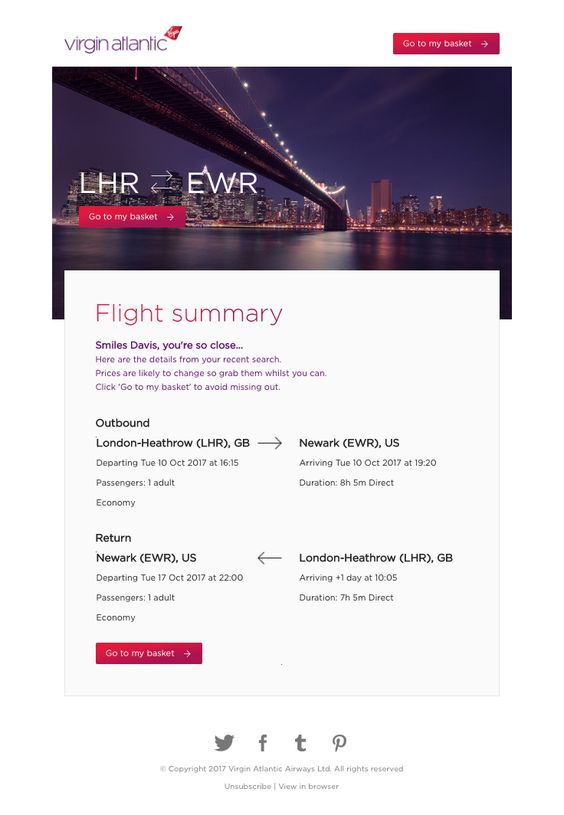
Email Copy
As mentioned earlier, a cart abandonment email is an opportunity to really play around with the content and that reflects in email copy that really stands out. You don’t need to write essays to convince your customers to come back, just a quirky one liner or a play on words is all it actually takes. Here are two great examples of simple yet quirky email copy.

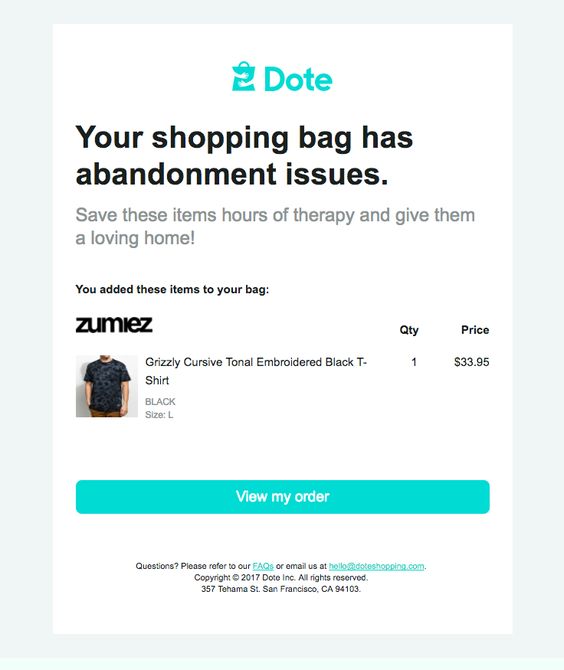
Notice the casual tone and distinctive copy - such small touches go a long way to set you apart in a cluttered inbox!
Reminder Of The Products In Their Cart
With an attention span of 8 seconds and our senses constantly being bombarded with visuals, everywhere we look - it only makes sense that we as humans respond well to visual stimuli. In the case of your abandoned cart email, it would make sense to recap or showcase what the customer has added to their cart as this serves as a great reminder of what they are missing out on. Pair this with an enticing subject line and convincing copy, and you are gold!
Graphics
Like I said, we humans are visual creatures, so when crafting your email - use colour themes and imagery that resonate with your brand. Animated gifs can also help make a great impression. Just take a look at Proactiv’s little animated shopping cart - it isn’t much but it does set the email apart from the static ones crowding an inbox.
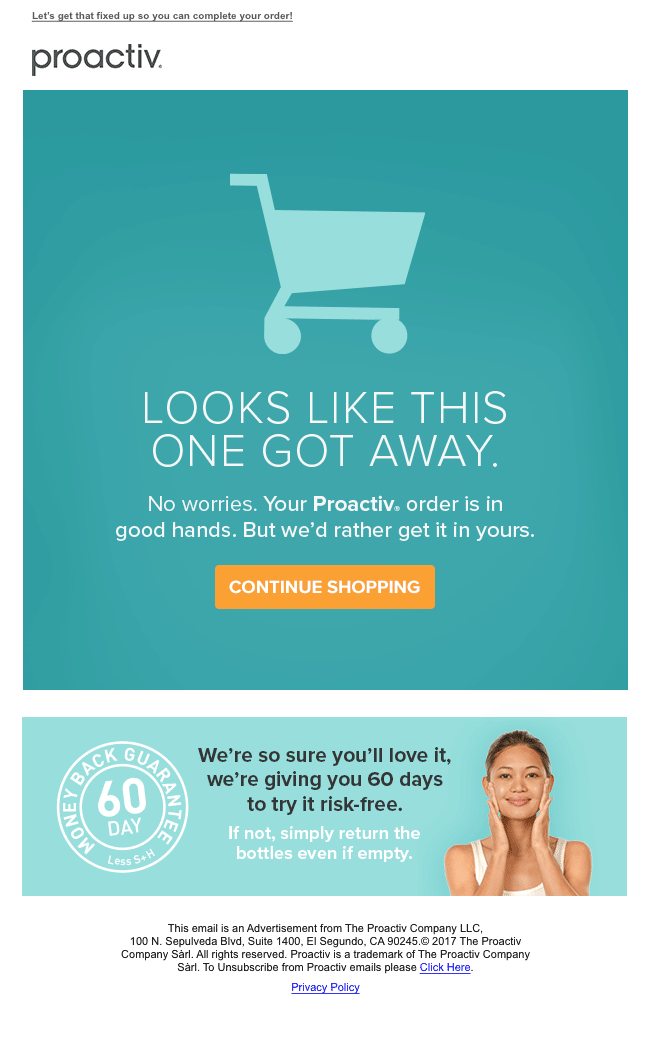
Offering Support
One of the reasons we see customers abandon their cart is when there is lack of trust or the feeling of support missing. A simple way of dealing with this is to build rapport with your customer and offering them a point of contact to ease their mind about such concerns. This also gives you a chance to interact with your customers directly, if they choose to reach out to you to gain clarity. See how AllBeauty includes this strategy in their main copy?
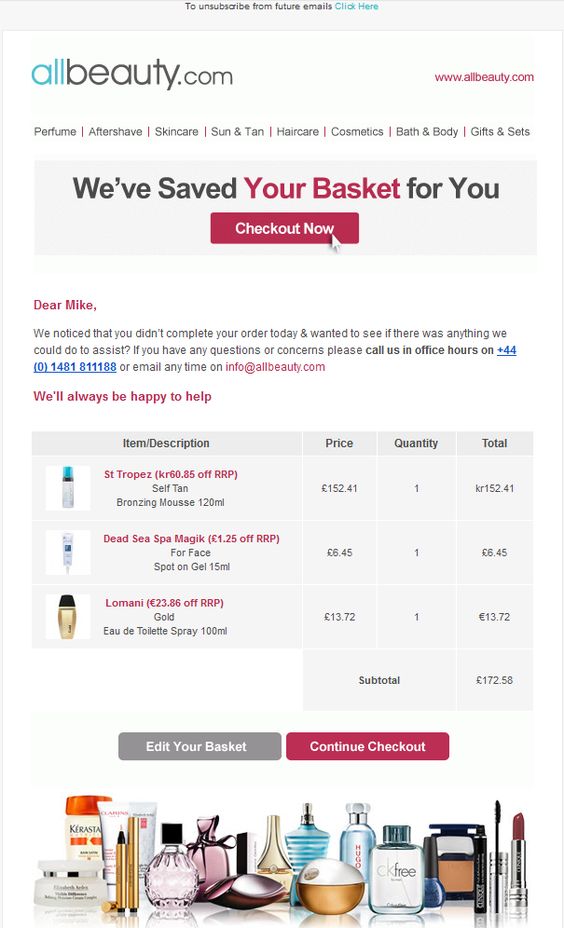
The Discounts
This one is an absolute no brainer. There is nothing that your customer will like more than paying less for the same product. If there is anything that is almost a sure shot way of converting a customer who is on the fence, it’s this! 54% of all customers say that they will buy the products in their cart if it were offered at a lower price. Keep in mind, for this to work, the incentive needs to be exclusive to the specific email and not a generic offer that was available on the website in the first place. While this is a winning strategy, be careful not to make it a habit as customers will come to get used to it and probably not shop until they receive a discount, instead of buying at full-price, thus making this strategy backfire.
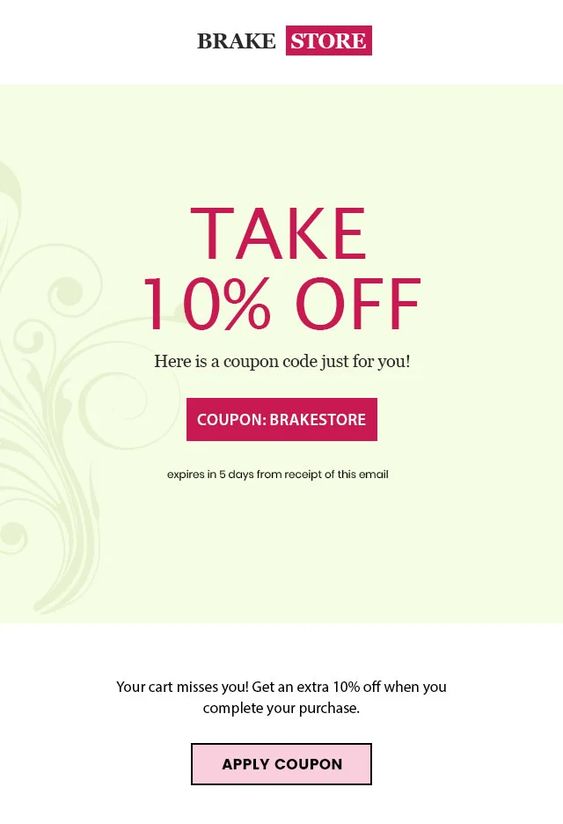
The Testimonials and Reviews
What do you do when you are contemplating buying a particular product online? Three times out of four, you will do your research, compare products and specifically look at the conversations around the product you are planning on purchasing - the reviews and testimonials matter the most. Therefore, if one of the reasons your potential customer has abandoned their cart is because they are unsure or confused - providing them with such context and customer reviews can be just the thing to tip them over to your side. Social proof can really work wonders, just check out this example:
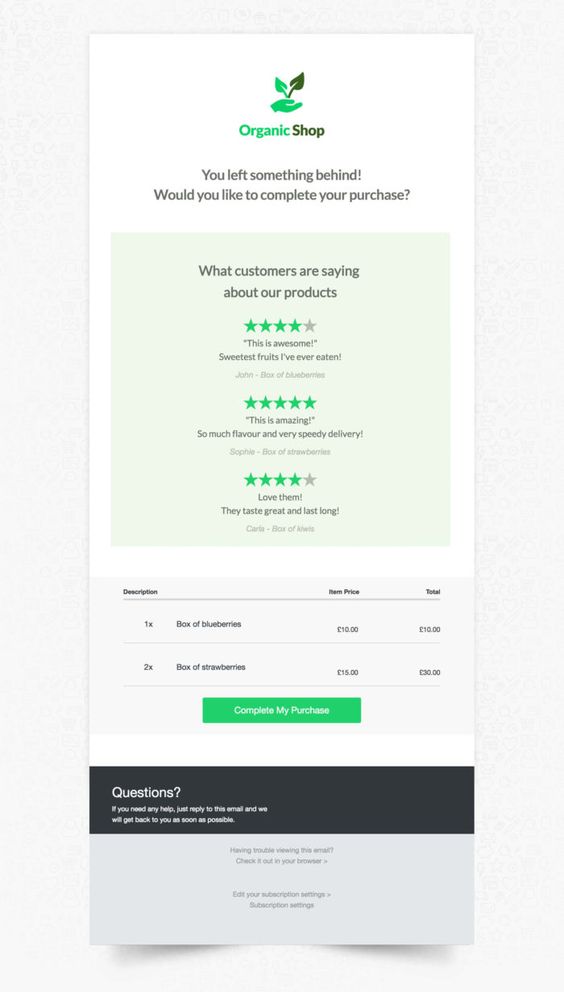
Making it Mobile Friendly
Remember how we discussed how a lot of customers are actually lost to the check-out process on mobile devices? Well, if you have fixed that issue, it’s also common sense to then ensure that your email is mobile friendly. Using animated graphics and certain imagery won’t always show up properly on smaller devices, so optimise those features for the same, instead of just eliminating them. Lush provides a pretty sweet mobile experience - those little bath bomb pictures look adorable and fit perfectly in the mobile optimised versions of the email:
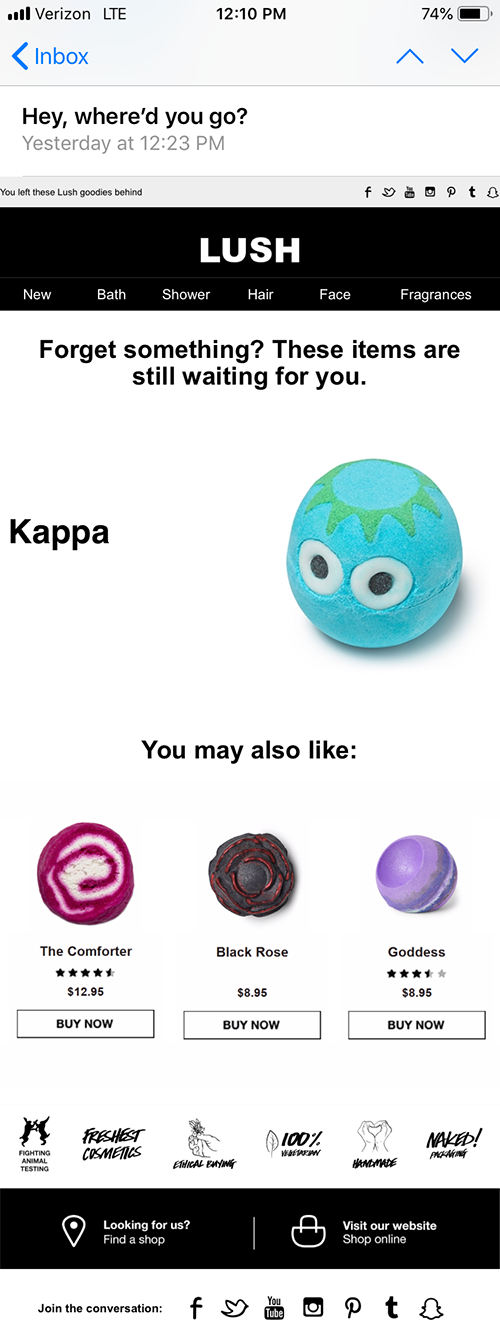
Creating That Sense Of Urgency
The FOMO is a reality that we all live with, even if we don’t always want to admit it. For decades, marketing strategies have hinged on creating a sense of the customer missing out on THE thing if they don’t buy a certain product. That same principle still works, and how! Especially when it comes to your abandoned cart emails.
This template by Red Rock combines clean visuals, a clear CTA, copy that does the job and a count-down gif that works wonder to create that sense of urgency. They alert potential customers to the scarcity of the products and put an actual visual timer on it - pretty brilliant!
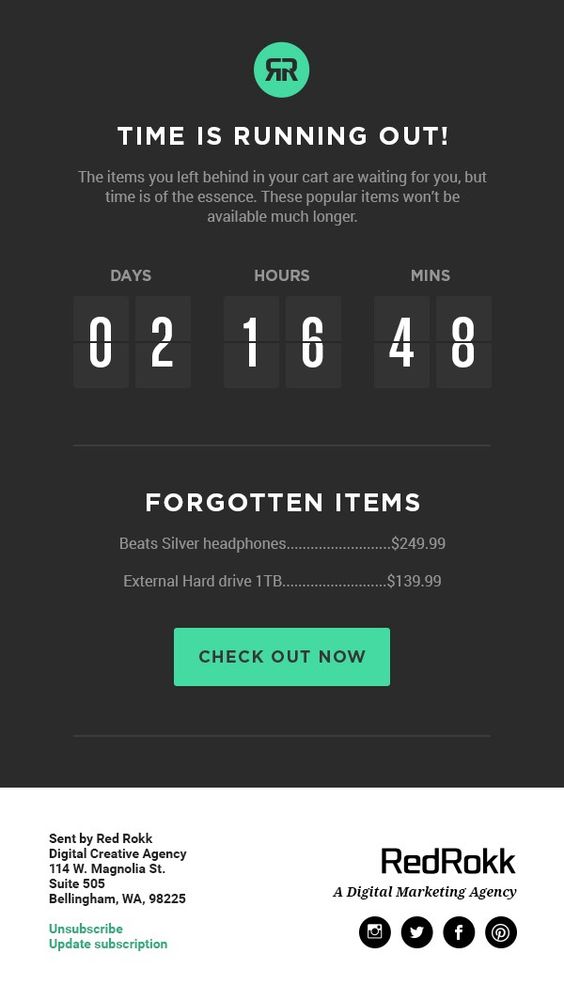
Timing Is Everything
The timing of your email to impact the cart recovery, plays a crucial role too! According to SalesCycle, these are the conversion rates for specific time brackets:
Emails sent:
- In less than an hour achieved on average a 3% conversion rate
- An hour later was the sweet spot, at an average 6.3% conversion rate
- Sent at 24 hours after a basket was abandoned achieved on average a 2.5% conversion rate
According to their research, a three part series works most effectively when used in conjunction with the right time brackets. Just keep in mind that each email in your series must be different from the other, to utilise one main strategy per email and if you plan on offering a discount, wait until the last email so that you don’t lose out on the customer possibly purchasing the product at full price!
There you have it folks! Go forth and turn those abandoned carts into $$$!
Enjoyed this article?
Get more email marketing tips delivered to your inbox. Join 4,000+ marketers.
No spam, unsubscribe anytime.


